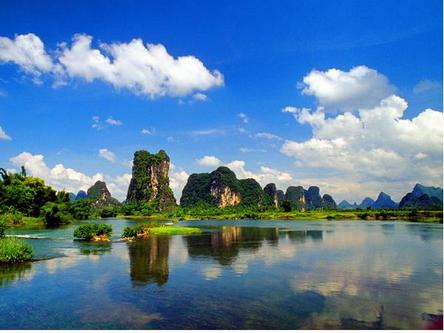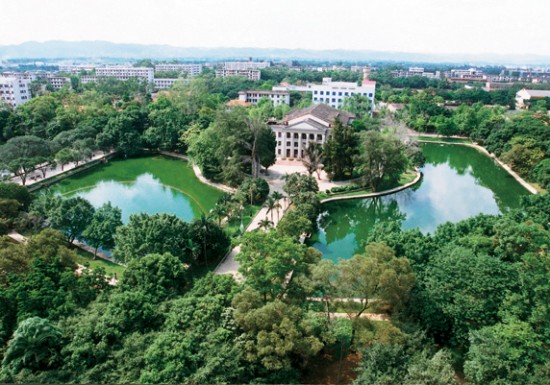


Guangxi (Zhuang Autonomous Region)
 |
 |
 |
General information on Guangxi’s development
The Guangxi Zhuang Autonomous Region is located in the south of China. It is the only one out of the five nationality autonomous regions that has the geographical advantages of close location to seas, rivers and the country border. The range from north to south is 610 kilometers, the range from east to west is about 750 kilometers, its total area is 236,700 square kilometers, which takes up 2.46% of the total area of the country and is ranked the ninth nationally. The geological situation of the whole province is “high at the edges, low in the middle”, which gives it the name as the “Guangxi Basin”. Within the whole province, 74.6% of the land is mountain, mesa and hill area, with the rest 25.4% as plain and water area. Guangxi has the highest river density in China with the total length of rivers of 34,000 kilometers. The coast line length at the land side is 1,595 kilometers. Guangxi has very mild sub-tropical climate with the average annual temperatures floated between 16~22.7 degree centigrade. Most of the areas within this province has no severe winter with the non-frozen days as long as 330~350 days per year. There are 37 different nationality groups reside in Guangxi. There are 12 bigger nationality groups, such as Zhuang, Han, Yao, Miao, Tong, Yaomu, Maonan, Jin, Hui, Shui, Yi, Qimu, etc, and another 25 smaller minority nationality groups. The total population of Guangxi in 2000 is 47.442 million, among which Han nationality takes up 61.66% with a population of 27.683 million and all the other nationalities 38.34% with a population of 17.211 million.
The general information on the economy development of Guangxi in 2004: 1. The most significant feature of the Guangxi economy in 2004: The provincial economy level achieved up to a new height with the breakthrough of the GDP reaching 300 billion RMB. 1.1 The “Three Industries” grew comprehensively with the strong increase of supplying capacity.
1.2 The “Main Three Demands” further encouraged the market growth and social consumption.
2. The rapid growing economy and optimized supplying/consumption structure further promote the high quality economic growth, which reached a new historical level.
3. The major problems in the economic development: The first huge problem is the autumn drought. The autumn drought which is very rare even every 50 years has great negative impacts on the agricultural production. Secondly, the supplying of coal –based electricity and the transports of soils is facing great controversies. Thirdly, the problem of how to efficiently introducing foreign investment is also bothering this region. According to statistics, the FDI in the whole year is $296 million US dollars, which is a sharp drop of 35.2% lower than last year the same period by comparison. Last but not least is the pricing problem. The whole province is experiencing a fast rising pricing growth with over-expected growth rate at prices.
At the Provincial Planning and Construction Conference, the Vice President of Guangxi Zhuang Autonomous Region, Zhang Wenxue, pointed out that the general development situation of the real estate industry in this region is as follows: the investment drop back on the real estate development is slowing down. The growth on real estate development scale is diminished. The land supply for residential buildings is more and more limited with the optimized structure of land supplying structure. The real estate credit grows steadily with slight setback on sales market. The general price of real estate is level off with small growth on average sales price. According to analytical statistics of relevant government departments, in the first half of this year, the total investment on real estate development is 10.6 billion RMB with a growth of 27.1% compared to the same period last year, which is 12% lower on growth rate by comparison. The Floor Space of Commercial Buildings is 28.063 million square meters with a growth of 34.8%, which is 13.2% lower on growth rate by comparison. Private credit loans in total for residential purchasing are 39.288 billion RMB with a growth of 29%, while the growth rate is 25.28% lower than the year before. The average price for commercial buildings is 2,177 yuan/square meter with a growth of 6.9% and 3.3% lower than the national level at the same time. The current real estate market of commercial residential buildings is well balanced with a slight drop back on market need. As pointed out, the real estate industry has become one of the most important leading industries of this province. In recent years, under the strict macroscopic readjustment and control, the real estate industry has achieved sustainable healthy development. In the first half of this year, the income from the real estate industry is 10.6 billion RMB taking up 6.5% of the total provincial GDP. At the same time, the provincial government also pays special attention to the control of the real estate market by stabilizing the prices. Some further measures include: 1) increase the supply of economical residential buildings. Up till now, 307 projects for economical residential buildings have been under construction with a total floor space of 4.62 million square meters. 2) build up and develop low-price renting houses systems with more than 5,000 low-price renting buildings available at the end of this year. Strictly control the removing and rebuild of old town buildings to prevent irrational rapid growth on the need of passive need on residential buildings. Develop and optimize the Real Estate Market Information and Alarming System in order to introduce rational investment and healthy consumption.
|
||||||||||||
|
||||||||||||
|